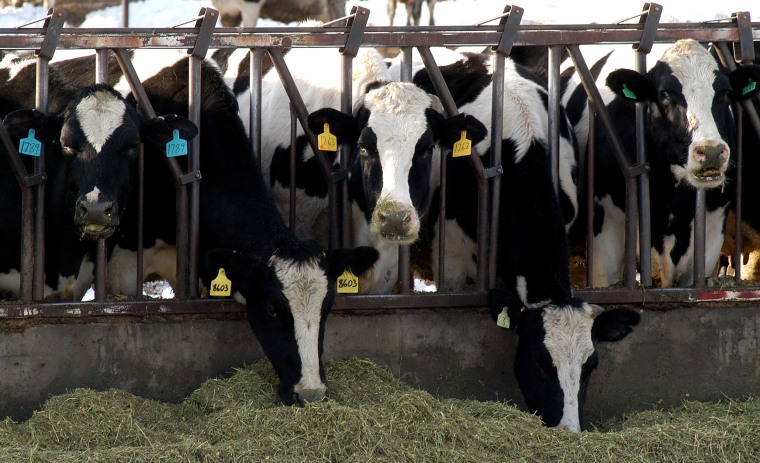A surprise blizzard in Washington state caused the death of more than 1,800 dairy cows across a little more than a dozen farms, leaving farmers to find a way to dispose of cattle that were a key source of their livelihood.
An arid region of the state, Yakima Valley is host to a number of dairy farms that use open lots for their cows, meaning their buildings are without walls. That’s typically not a problem because the area only gets six to eight inches of rain per year.
But on Saturday farmers said that a storm forecast to bring three to five inches of snow, already a large snowfall by their standards, suddenly dropped 18 to 24 inches with winds of 40 to 50 mph and gusts of up to 80 mph.
Jason Sheehan, 44, has run a dairy farm of 5,000 cattle for 17 years in the valley. On Saturday, more than 200 of his cows were killed in the storm. He has never seen anything like it, he said, adding it is only the latest challenge for struggling dairy producers.
“It’s been four years of thin margins and losses,” said Sheehan, who employs 35 people on his dairy farm. “We’ve been struggling financially for four years, and now Mother Nature is throwing another twist. It’s a tough time to take this on.”
Most of the farms in the area are medium to large dairies that milk 3,000 to 5,000 cows apiece, according to Stuart Turner, an agronomy consultant for farms in the region.
Turner said that farmers weren’t prepared for a storm of this magnitude, but did what they could to protect their herds. Some went so far as to build walls out of hay bales to provide the cows some shelter.
But to stay warm in the dropping temperatures, the cows clustered together and some were trampled or crushed in the process. Farmers couldn’t get the animals, which each weigh around 1,200 pounds on average, to move.
“It’s just brutal” for dairy farmers, which is already "the toughest corner in agriculture," Stuart said. "Compared to 2013, total farm income on average is down 40 percent. Name an industry that has to maintain the same cost base and take a 40 percent hit and keep going.”
The cows themselves are worth on average $2,000 each, meaning that the farms collectively lost millions of dollars as well as their animals.
Sheehan said that during the storm his farm had to stop milking for the first time since it opened in 1978. It was also the first time he ever remembers milk trucks not making the rounds to pick up milk, as the area usually is spared such extreme weather.
"There were a whole bunch of dairymen working in that storm, trying to do whatever they could for all these animals,” Sheehan said. “We have a really great team of people around here, and all these employees put their heart and soul in this and there are a lot of tears around here.”
But farmers did not have time to mourn their losses, as many had to go right back to work as well as figure out what to do with the cows that died.
“What people are hearing about right now is the devastation caused by the storm, but what they don’t realize is that these farms have to keep running,” said Kimmi Devaney, director of community relations for the Dairy Farmers of Washington, who pointed out that cows have to be milked two to three times a day.
“It really showcases the spirit of the dairy community that farmers who weren’t heaviest hit have come out to help those who are in hard times,” she said.
While no definite plans had been made as of Wednesday, Steven George, the issue management coordinator for the Washington State Dairy Federation, said farmers are attempting to compost the bodies in lieu of a mass grave, which could negatively impact groundwater.
“There is on-farm compositing of mortalities,” George said. “That is an accepted practice, but this is probably going to overwhelm that. They are used to doing a couple a day. We are looking at some other potential options.”
George said possibilities include composting the carcasses at the port authority in Sunnyside, Washington, or at a landfill across the state border in Oregon.
Shaheen, meanwhile, said he and his employees are remaining focused on the cows they still have.
“We have to take care of what’s living and make sure they’re comfortable and watered and milked and everything,” he said. “We’ve tried to focus on what‘s left instead of getting down about what didn’t make it through the storm.”
CORRECTION (Feb. 14, 2019, 2:15 p.m. ET): A previous version of this article misstated where the remains would be composted. The cows may be composted at the Sunnyside Port Authority in Washington state, not at a pork facility.


